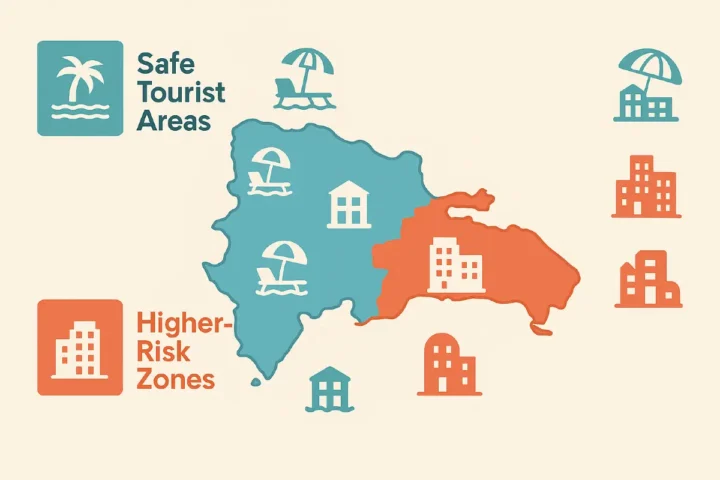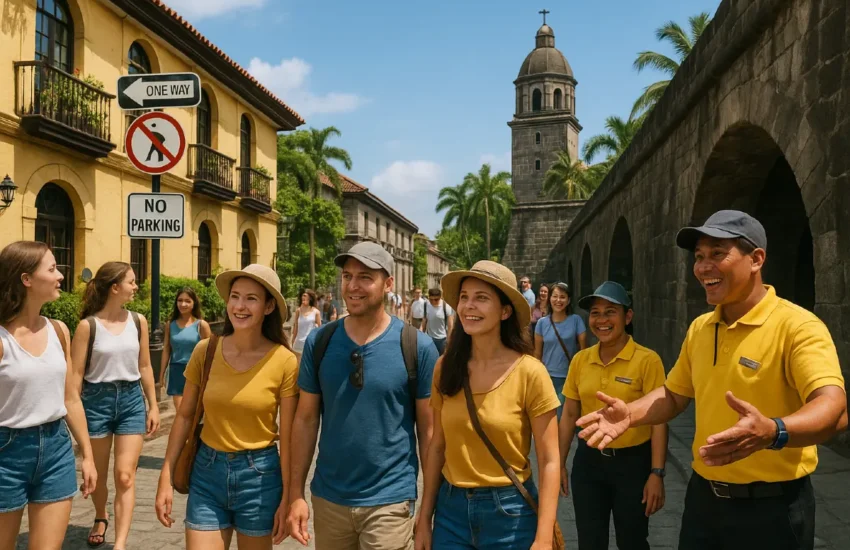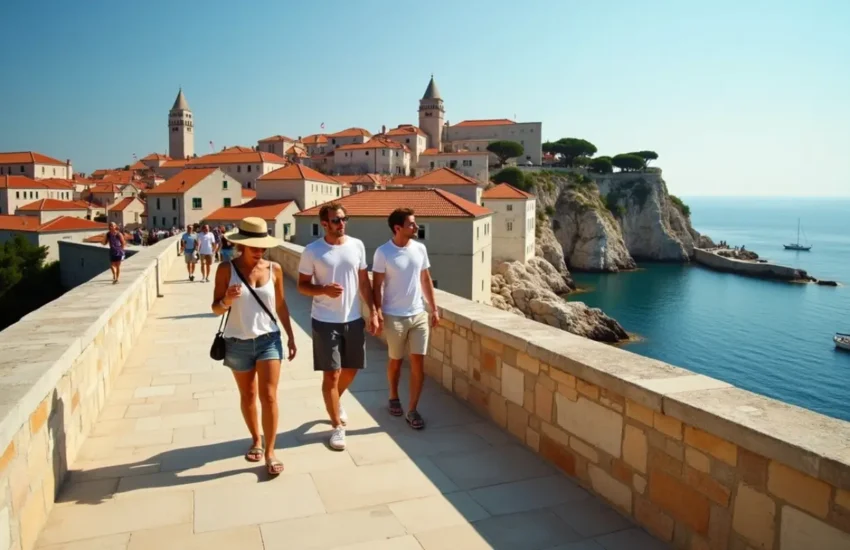Is Dominican Republic Safe?
The Dominican Republic attracts visitors with stunning beaches and vibrant culture, but is Dominican Republic safe? Travelers should stay alert due to the country’s high crime rate. Tourist areas frequently experience petty crimes like pickpocketing and bag-snatching. Armed muggings have been reported in broad daylight.
Safety concerns persist despite increased police presence in tourist zones. The country maintains a dedicated tourist police force (POLITUR). Police response times can be slow outside resort areas. Some locations need extra caution than others. Many tourists enjoy trouble-free vacations, but understanding local safety issues matters.

Road safety deserves special attention. The country has the world’s highest road crash mortality rate at 65.2 deaths per 100,000 people. Smart travelers should research the local cost of living and Dominican Republic’s weed laws before booking their trip.
Is the Dominican Republic Safe to Visit Today?
The safety of the Dominican Republic isn’t a simple yes or no answer. Travelers looking at Caribbean destinations need to know the real picture before booking their flights to Punta Cana or Santo Domingo.
Current Travel Advisory Levels
The U.S. State Department rated the Dominican Republic as a Level 2 destination in June 2025. This means tourists should “Exercise Increased Caution” because of crime risks. Countries like Italy, Germany, and Jamaica share the same rating. Canadian officials suggest “a high degree of caution”. British authorities point out “high crime rates” but mention most tourists stay safe.
The 2024 Global Peace Index ranks the Dominican Republic at 81st among 163 countries. This puts it ahead of Mexico, Brazil, and Colombia. All the same, violent crime remains an issue despite more police presence in tourist spots.
Tourists can rely on POLITUR (dedicated tourist police), a 911 emergency system, and security staff at most resorts. The country’s government takes tourist safety seriously and puts money into protecting this key part of its economy.
What Local Residents Say about Safety
Locals paint a different picture of safety than official warnings. Take Las Terrenas, a relaxed beach town in the Samaná Peninsula. Residents describe it as friendly with few serious crimes. Most security problems involve stolen motorbikes or pickpocketing that happens when people leave their stuff unattended.
Many areas have created shared safety approaches. Hotels and shops in Las Terrenas team up with local police to handle problems quickly. Hotel owners and locals often help tourists who look lost—creating a friendly network that keeps visitors safe.
How Safety Varies by Location
Location plays a big role in safety. Different areas show different risk levels:
Punta Cana stands out as one of the Caribbean’s safest spots. The CESTUR police force watches over tourists here. Violent incidents rarely happen, even outside resort areas.
Santo Domingo tells a different story. The Colonial Zone (Zona Colonial), a UNESCO World Heritage Site, has good security and works well for walking tours. But areas like Cristo Rey, Villa Consuelo, and Villa Juana see more crime.
The western border next to Haiti needs extra care. This area faces more unrest and uncertainty. Staying at least 10 kilometers away from this border makes sense due to lawlessness and gang activity.
Most visitors who stick to tourist areas and stay alert will be safe in the Dominican Republic. Learning about living costs and local laws helps tourists understand what to expect and avoid legal troubles.
Your safety in the Dominican Republic comes down to your chosen location, travel timing, and awareness of what’s happening around you.

Understanding Crime in the Dominican Republic
Crime patterns in the Dominican Republic need tourist attention, especially from those looking for sunshine and adventure. These patterns help visitors answer a simple question: is Dominican Republic safe for their travel style?
Petty Theft and Pickpocketing
Petty theft stands out as the most common security issue for tourists across the Dominican Republic. Criminals snatch bags, pick pockets, and steal opportunistically in crowded urban areas like Santo Domingo. Thieves on scooters, mopeds, motorcycles, or bicycles grab anything they can reach. This often leads to injuries along with stolen property.
You might think resort areas are safer, but they face similar issues. Thieves target resorts, beaches, hotel rooms, and even room safes. Tourists often become easy targets at airports and bus terminals. The cost of living in Dominican Republic might be lower in small beach towns, but visitors should stay alert to prevent theft.
Violent Crime and Armed Robbery
The safety situation gets more complex with violent crime. The U.S. State Department points out that “violent crime, including armed robbery, homicide, and sexual assault, remains a concern throughout the Dominican Republic”. These risks affect everyone, whatever their nationality.
Tourists report being robbed at gunpoint or knifepoint during daylight hours while walking through residential areas. Women traveling alone face extra risks from aggressive sexual behavior and assault. Resort areas provide better security thanks to “Politur,” a dedicated tourist police force. Yet crimes still happen even in major resorts and hotels.
Economic gaps, high unemployment rates, and income inequality explain why this happens. The security situation becomes more complex due to “wide availability of weapons, the use and trade of illicit drugs, and a weak criminal justice system”.
Online Scams and Dating App Risks
Dating apps have created new safety concerns over the last several years. Tourists using dating apps should be extra careful in the Dominican Republic today.
Recent cases show criminals robbing U.S. citizens through dating application meetups. Scammers find tourists on location-based dating apps and set traps that lead to dangerous situations. They act caring and genuine but plan to cause serious harm.
The digital world brings other risks too. Cybercrime, malware attacks, and online extortion happen often. Credit card and ATM fraud run rampant, especially in Santo Domingo and resort areas. Digital safety needs just as much attention as physical safety.
How to Avoid Becoming A Target
To stay safe in the Dominican Republic, tourists should follow these key precautions:
- Leave expensive watches or jewelry at home
- Keep phones and devices hidden and know where they are
- Use ATMs inside hotels or shopping centers during the day
- Give up belongings without fighting back if robbed
- Meet online matches in public places after video chatting
- Travel with others instead of alone
Learning about Dominican Republic weed laws and local rules helps avoid risky legal situations. Dating app users should take extra care – wait to share personal details and stick to public meeting spots.
The Dominican Republic can be safe with the right precautions. Smart travelers who stay aware of risks and follow safety guidelines usually avoid trouble. These guidelines substantially reduce your risk even in areas with higher crime rates.
Health and Medical Safety for Travelers
Health risks and crime concerns both play a role in the Dominican Republic’s safety for travelers. My first-hand experience with the Dominican healthcare system has taught me vital details that will help keep you healthy during your Caribbean adventure.
Mosquito-borne Illnesses: Dengue, Zika, malaria
Mosquito-transmitted diseases continue to be a major health concern for anyone asking about Dominican Republic safety. The country reported 10,784 dengue fever cases and 39 deaths in 2022. The May-November rainy season sees increased transmission rates, though the disease exists year-round.
Previous reports show cases of Zika virus, which creates special risks for pregnant women due to possible birth defects. The western provinces bordering Haiti face malaria risks, with 335 cases documented in 2022.
To stay protected:
- Use DEET-based insect repellent, particularly at dawn and dusk
- Cover up with long-sleeved shirts and pants outdoors
- Check your room is insect-proof
- Rural stays require mosquito nets
Food and Water Safety Tips
Food and water safety requires careful attention in the Dominican Republic. The country’s tap water isn’t safe to drink anywhere. Ask for bottled water at restaurants and hotels. Unless you’re sure the ice comes from purified water, skip it altogether.
Street food and beach vendors pose higher risks, even in tourist-heavy areas. You can avoid “travelers’ diarrhea” by washing hands often, staying away from raw or undercooked seafood, and being careful with unpasteurized dairy products.
Access to Hospitals and Emergency Care
Medical facility quality differs greatly throughout the country. Tourist areas have decent private hospitals with English-speaking staff. These facilities often need payment upfront or proof of insurance before treatment. Public hospitals lack basic resources, supplies, and English-speaking staff.
Santo Domingo residents can dial 911 for emergencies. Other areas should contact the tourist police (POLITUR) at +1 809 200 3500. The cost of living helps explain why private healthcare might seem expensive to visitors, yet it’s the safer choice.
Travel Insurance and Medical Evacuation
Healthcare costs make the Dominican Republic risky without proper insurance. U.S. health insurance plans don’t work abroad, which leaves travelers open to big medical bills.
Medical experts suggest getting at least $100,000 in emergency medical coverage and $250,000 for medical evacuation. This makes sense since emergency flights from the Caribbean can cost more than $50,000. Unlike the country’s weed laws that change by location, you need comprehensive travel insurance everywhere.
The U.S. State Department strongly advises against traveling without medical evacuation coverage. Budget-conscious travelers should remember that good travel insurance is worth every penny.
Transportation and Road Safety in the Dominican Republic
Road safety poses the deadliest threat to travelers in the Dominican Republic. The country leads the world in road crash deaths with 65.2 fatalities per 100,000 people. These numbers should shape your transportation choices during your stay.
Driving Conditions and Accident Risks
Drivers need extreme caution in the Dominican Republic. Major highways and tourist routes stay well-maintained. Rural roads tell a different story with unmarked speed bumps, potholes, and missing manhole covers. Local drivers often break traffic laws. They speed, weave through lanes, and drive without lights after dark. Animals roam the roads freely. The country’s cost of living affects vehicle maintenance standards, which makes accidents common.
Public Transport and Taxi Safety
Safety standards remain a concern on public busses and “guaguas” (shared vans). Street taxis near Las Americas International Airport have seen armed robberies. Your safest bet is to use hotel-arranged services or trusted companies like Apolo Taxi. Motorbike taxis (“motoconchos”) come cheap but are dangerous.
Using Ride-share Apps like Uber
Uber runs in Santo Domingo, Santiago, Puerto Plata, and Punta Cana. These services offer a safer option with better-maintained vehicles. Ride-sharing apps give you tracked trips, fixed prices, and cars with working seatbelts. Traditional taxis lack these simple safety features.
What to Do in Case of A Road Accident
After an accident, secure the site and dial 911. Dominican laws require detention of drivers in serious accidents until investigations end—even innocent parties. This process might take weeks or months without a settlement. The strict laws might seem daunting. Knowledge of Dominican Republic weed laws and driving rules helps minimize your risks.

Natural Disasters and Environmental Hazards
Natural hazards create unique safety challenges for Dominican Republic travelers. Visitors need to understand these risks to prepare well for their Caribbean adventures.
Hurricane Season and Flood Risks
Hurricane season hits the Dominican Republic from June through November. September sees the most storm activity. These powerful storms bring torrential rains and fierce winds that often trigger devastating floods and landslides. The country has faced direct hits from 11 hurricanes over the last century.
Climate change has made these weather patterns more intense. Such events disrupt basic services and damage agriculture. Hurricane Fiona showed how big the impact can be – it caused more than 26 million US dollars in damage during 2022.
Earthquakes and Tsunami Zones
The Dominican Republic lies in an active earthquake zone. The country has faced six tsunamis since 1751. The deadliest tsunami struck in 1946, reaching 5 meters and claiming 1,790 lives. Experts rate the tsunami risk as low but real. There’s a 2% chance a dangerous tsunami could hit within the next 50 years.
How Resorts Prepare for Natural Disasters
Major resorts take hurricane safety seriously. To cite an instance, see Casa de Campo’s approach – they maintain hurricane shelters, evacuation plans, and offer a 100% hurricane guarantee policy. Upscale properties feature storm-resistant buildings, backup power systems, and proven safety measures.
Emergency Preparedness Tips
Here’s what you need to know about staying safe from natural disasters in the Dominican Republic:
- Keep bottled water, non-perishable food, and medications ready
- Store passports and vital documents in waterproof containers
- Learn your hotel’s evacuation routes
- Check the National Hurricane Center for weather updates
Many people research Dominican Republic’s cost of living but miss emergency preparation costs. Unlike the country’s weed laws, natural disaster safety rules make sense and matter greatly. The Dominican Republic can be safe from environmental threats with good planning. Just remember to think carefully about hurricane season travel risks.
Is Dominican Republic Safe Frequently Asked Question
Is it Safe for Tourists to Visit the Dominican Republic?
While the Dominican Republic has some safety concerns, most tourists enjoy trouble-free visits, especially in popular resort areas. Exercise caution, stay aware of your surroundings, and take basic precautions like avoiding displays of wealth and being vigilant with personal belongings.
What are the Main Safety Concerns for Travelers in the Dominican Republic?
The primary safety concerns include petty theft, pickpocketing, and road safety. Violent crime can occur but is less common in tourist areas. Be cautious when using public transportation and consider using reputable ride-sharing services or hotel-arranged taxis.
How can I Protect My Health while Visiting the Dominican Republic?
To stay healthy, use insect repellent to prevent mosquito-borne illnesses, drink only bottled water, and be cautious with street food. It’s also advisable to have comprehensive travel insurance that includes medical evacuation coverage.
Are Natural Disasters A Significant Risk in the Dominican Republic?
The country is susceptible to hurricanes, particularly from June to November, and is in an active earthquake zone. However, major resorts have safety protocols in place. Stay informed about weather conditions and follow any evacuation instructions if necessary.
How much Money should I Budget for A Trip to the Dominican Republic?
The amount you need depends on your travel style, but $100 USD can cover daily expenses for budget travelers. However, for a comfortable stay including activities and dining out, plan for a higher budget. Remember to account for unexpected expenses and emergency funds.
What Areas of the Dominican Republic are Considered Safest for Tourists?
Popular resort towns like Punta Cana, La Romana, and Puerto Plata are generally considered safe, with heightened security and well-developed tourism infrastructure. These areas typically experience lower crime rates compared to major urban centers.
How Reliable is Public Transportation in the Dominican Republic?
Public transportation, such as local buses and motoconchos (motorcycle taxis), can be unsafe due to reckless driving and lack of safety standards. Tourists are encouraged to use private transfers, hotel shuttles, or reputable ride-hailing services for safer travel.
Do I Need Any Vaccinations before Traveling to the Dominican Republic?
While not mandatory, travelers are often advised to have vaccinations for Hepatitis A, Typhoid, and routine immunizations. For extended stays or rural visits, Hepatitis B and Rabies vaccines may also be recommended. Always check with a healthcare provider before travel.
How Common is English Spoken in the Dominican Republic?
Spanish is the official language, but English is widely spoken in tourist areas, resorts, and by service staff. In rural or non-tourist regions, English may be limited, so learning basic Spanish phrases can enhance communication and safety.
What Travel Documents Do I Need for the Dominican Republic?
Most tourists need a valid passport and may be required to complete an electronic entry and exit form (E-Ticket). Depending on your nationality, a tourist card or visa might also be necessary. Always confirm entry requirements before traveling.


